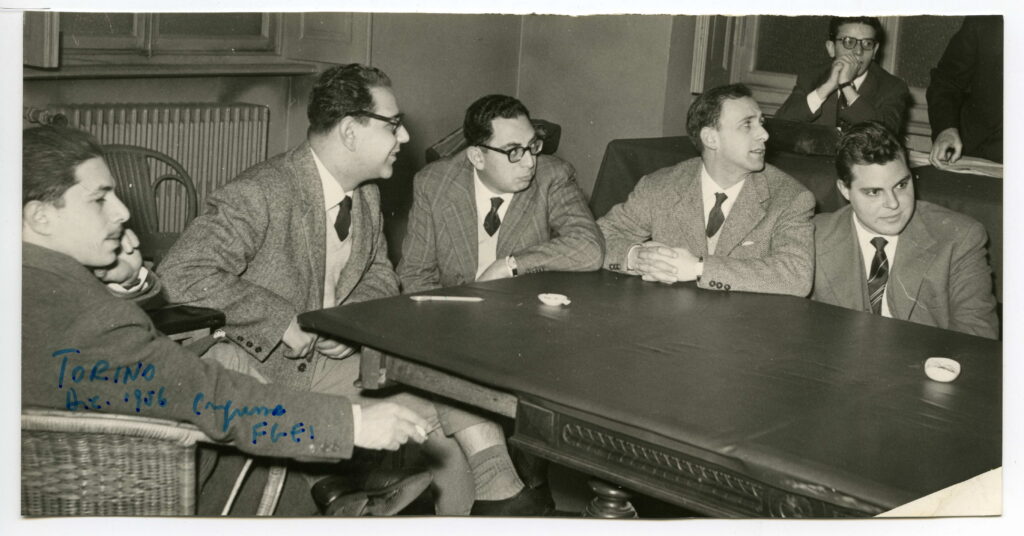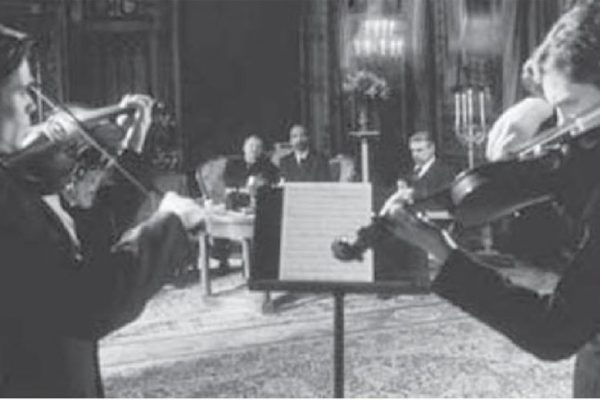Guri’s Schwarz’s After Mussolini: Review by Paul Arpaia

After Mussolini: Jewish Life and Jewish Memories in Post-Fascist Italy, the translation of Guri Schwarz’s Ritrovare se stessi. Gli Ebrei nell’Italia postfascista is one of the most important Italian historical studies translated in 2012. This two-part study of Italian Jews “(re)discovering themselves ” (the literal translation of part of the original title in Italian) is the result of Schwarz’s painstaking archival research in public and private collections in Italy and Israel. It is the fruit of his close readings of diaries, memoirs, newspapers and works of literature. It is the synthesis of his skillful use of multidisciplinary theoretical approaches to the study of memory.
Schwarz’s study offers something for anyone interested in modern Italian and Jewish studies. It is especially an invaluable resource for specialists and anyone curious about the Shoah’s impact on the self-imaging of Italian survivors and their children and grandchildren. Schwarz’s work raises larger questions about the relationships between the constructions of individual and group identities, on the one hand, and an impressive wide array of topics ranging from foreign policy, to religious practices, to national identity and to the production of professional works of history, on the other. Giovanni Noor Mazhar translates Schwarz’s prose into a smooth and easy-to-read English.
The first part of Schwarz’s study is an institutional history examining the vicissitudes of Italian Jews and Italian Jewish organizations from 1943 through the 1950s, with instructive excurses for non-specialists to earlier historical landmarks in Italian and Jewish history, including the unification of Italy, the Fascist Era, the creation of the Union of Italian Jewish Communities (or UCII in 1930) and the Racial Laws (1938). Drawing primarily on documents from the Central Italian Archives, the Archivio Centro di Documentazione Ebraica Contemporanea (CEDEC), the archives of the Jewish communities in Rome and Milan and archives in the State of Israel, Schwarz reconstructs the struggle for leadership in the UCII, beginning with the period from 1943 to 1945, now generally accepted as a civil war in the light of Claudio Pavone’s path-breaking work(1).
Schwarz’s originality in the (re)construction of Jewish institutions is to be found in the manner in which he injects an international dimension into the civil war. On the one hand, he analyzes the impact of the growing presence of international Jewish organizations. On the other hand, he considers how the presence of Jewish volunteers in the British army represented to current and future Jewish leaders new ways of being Jewish.
Schwarz discusses the strengthening ties between Italian Jewish and international organizations with a particular focus on the American Joint Distribution Committee, the World Jewish Congress and Zionist groups in Palestine and the State of Israel. Experiences of persecution, interactions with Jewish troops, participation of Italian Jews in international Jewish organizations and the founding of the State of Israel also influenced a Zionist reawakening among Italian Jews, even if many decided ultimately to remain in Italy after the war. Schwarz explores in great detail the varied ways in which Jewish communities reestablished and constructed institutions, youth organizations, schools, rituals, commemorations and myths through which Italian Jews could live in a multiplicity of ways as Jews in Italy.
Without discounting the importance of ideology, Schwarz emphasizes the importance of generational differences over the direction of Italian Jewish institutions in postwar Italy. He documents the ways in which Jewish institutions participated in the drafting of the Italian constitution and the formation of the Italian Republic. His discussion of the UCII’s role in the drafting of Article 8 in the new constitution (guaranteeing religious freedom) is particularly enlightening. He captures the quandary of the UCII in its leaders’ desire to remain politically neutral in the immediate postwar period and its wish to see the rights of religious diversity enshrined in the new constitution.
Schwarz points out that despite the bests efforts of the UCII in 1947, including its collaboration with the Waldensian community, the principal of religious equal freedom would only begin to gain currency in Italian society in the 1980s. In contrast to the cautious approach of the older generation, many members of the younger generation wanted Jewish organizations to become involved in the subsequent political divide between the Christian Democrats and the leftist opposition.
Schwarz explores the process by which Italian Jewish organizations became more involved in Italian politics at the end of the 1940s and the beginning of the 1950s with the debate over what to do with Germany, with the growing divide in Italy and Europe regarding the State of Israel during the 1960s and 1970s and with the reemergence of new forms of anti-Semitism and waves of terrorist acts aimed at Jews living in Italy and Europe in the 1970s and the 1980s.
In the second part of his study, Schwarz focuses on the (re)structuring and the (re)organization of memory after the fall of Mussolini. He argues that that the way in which the Shoah fit, or did not fit, into the construction of memory among Italians offers a means by which one can understand both the processes of self-representation and the results of those processes – whether the results fit under the categories of Jewishness or Italianness. One of the invaluable attributes of Schwarz’s work on memory is the sensitivity with which he approaches his topic. His analysis is free of easy moral judgments about historical figures, unspoken assumptions about what should have been, and the presentation of the past in the light of some inexorable historical path to the author’s perception of the present.
Drawing on private and public writings from the immediate postwar period of those who lived through the Shoah in Italy, Schwarz demonstrates how, despite dissenting voices, the construction of memories, after Italy switched sides and joined the Allied war against Nazi-Fascism in 1943, emphasized the protection of Jews over the persecution of Jews prior to that year.
For Jews, the motive force was a fervent desire to be reintegrated back into the Italian community from which the Racial Laws had torn them. For antifascist non-Jews, the construction of memory after 1943 of a “true Italy” that had been impervious to both anti-Semitism and Fascism fit neatly into the myth of the Resistance. This myth became a sort of dark matter from which the universe of the Italian Republic could emerge and grow. Schwarz offers as a key to understanding this process Giacomo Debenedetti’s Otto ebrei (1944) in which the writer argued that Fascist anti-Semitism and the constructed memory of anti-Fascism’s protection of Jews were two sides to the same coin objectivizing Jews as a key ideological reference point.
Schwarz argues that Italian Jewish losses had to be contextualized in the totality of losses during the war to make the Jewish losses an integral part of a collective loss. Schwarz’s point is that addition to serving as the touchstone of postwar Italian and Italian Jewish identity, the history of the Shoah is an intrinsic part of human history. If the history of Jews is just for a Jewish audience, it loses its full value.
For this American reviewer who teaches the history of Nazi Germany and the Shoah, Schwarz’s point has important meaning. The welcomed inversion of historical studies from the bottom up in the 1960s has too often resulted in so many segregated histories that are specially packaged and targeted to different consumer markets: Jewish studies for the Jews, Italian studies for Italians (and Italian-American) women’s history for the women, LBGT history for the LBGT community, African-American history for the African-American community, and so on. While the memory of the Shoah in Italy became a central core of Italian Jewish identity and although the history of the Shoah is unique in human existence, to make its history solely about the Jews is to empty the Shoah of its historical meaning of what humanity was capable and willing of doing through state-sponsored antisemitism.
Schwarz makes another important point. The Catholic Church and the principal Italian political and cultural figures in the post-Mussolini era needed to exculpate Italy of the Shoah by remembering anti-Semitism as a German import to Italy, with the Fascist government playing the role of abettor. Schwarz points to the efforts of political figures, like Francesco Saverio Nitti, Don Luigi Sturzo, Stefano Jacini, and cultural figures, like Benedetto Croce, Corrado Barbagallo and Giacomo Perticone, who aimed at exculpating the Italian Republic and Italian civilization of a collective guilt in order to ensure that Italy would not suffer a fate similar to Germany in postwar Europe.
These efforts paralleled a phenomenon that Donald Bloxham explores in his study of the Nuremburg Trials. The trials’ political rather than juridical nature turned a few Nazi leaders into scapegoats for all the others who played a part in the destructive anti-Semitism unleashed by Nazi Germany (2).
In Italy, starting from the period 1943-1945, the government was interested in propagating the myth of Italy as a victor of the war against Nazi-Fascism and in portraying anti-Semitism as being foreign to Italy. If the need for a peace treaty between the Allies and Italy incontrovertibly signified that Italy was a defeated nation, continued efforts by Italian diplomatic and political leaders in the postwar period fostered a successful narrative of an ahistorical good Italian people (Italiani, brava gente) who, unlike the Germans, had remained immune to anti-Semitism. This myth could only be maintained so long as Italian anti-Semitism could be glossed over. Thus, Schwarz argues, there was a collective psychological imperative for forgetting the Shoah in Italy.
Schwarz hints at an important point throughout his study about the appeal of modern Italy in the memory of the older generation of Italian Jews. He might have made the point more clearly by making the important distinction between state-sponsored anti-Semitism and anti-Semitism tout court.
The liberal Italian state played a vital role during the Risorgimento in abolishing state-sponsored anti-Semitism, a role played previously by France and the French Revolutionary armies on the Italian peninsula. With the abolition of the ghettos and the granting of full citizenship to Italian Jews, the monarchy asserted the new Italian state’s cultural-political hegemony over the former states and their political acolytes, including the Papal States and the pope-king.
The Savoyard monarchy thus appeared to advocates and foes alike as the guarantor of Jewish inclusion in a reimagined national community. For Italian Jews it appeared that so long as a Savoy remained on the throne, they could be reassured that they would no longer suffer from state-sponsored anti-Semitism. The betrayal first of Mussolini and then of Victor Emanuel III came as shocks to their sense of identity and belonging to the Italian community. To be Italian after 1938 meant that one could not be what the state defined legally as being Jewish.
Schwarz finishes his study with several important conclusions. Drawing on the theoretical works of Tzvetan Todorov, Max Weber, Yeshayahu Leibowitz, and Shmuel Trigano (among others) he starts from the premise that “socio-territorial rootedness” is one of the constituent elements of human identity. When placed under duress, compensatory processes begin that allow those suffering from a state of uprootedness to deal with their sense of disorientation.
In the period from 1943 to the 1970s Italians Jews resorted primarily to four compensatory mechanisms: (1) a reassuring memory that sought refuge in daily life and reinforced pre-political ties of language, culture, familiar places and loved ones; (2) the search for new means of identification with the national community by self-representation through anti-Fascism and Resistance; (3) an adherence to ideological paths that proposed a radical transformation of society, such as communism; and (4) an accented cohesion of belonging to a Jewish collectivity, such as Zionism.
(Re)discovering one’s Jewishness did not necessarily mean a return to orthodoxy. The persecution gave a new form and consistency to the Jewishness of many Italians: it became a public fact. They were no longer Jews at home and Italian citizens outside the home. State-sponsored persecution served as a catalyst for an evolutionary process that had already begun before 1938. Persecution heightened tensions among the different currents among Italian Jews, but it also created a new sense of Jewish solidarity and a different way of living as individuals and as a collectivity.
After the Shoah, if Italian Jewish institutions and internal self-regulation remained orthodox, the majority of Italian Jews did not practice their faith with the exception of going to synagogue on the high holy days. If they viewed the synagogue and the Hebrew school as the heart of community life, they constructed a Jewish identity as an abstract sense of being different.
Schwarz argues that the essence and embodiment of Jewish identity by the 1980s continues to be Memory. Schwarz uses the uppercase here to signify that Jewish memories of the Shoah gave memory, now, as an absolute value for contemporary Italian Jews, the central place that religion used to have in the self-representation of Jewishness.
One final note must be made about typos in the text. While many were minor (and, I conjecture, the fault of a copy editor rather than the translator) a glaring error on page 31 requires correction in this review. The Italian word “stirpe” somehow became the English word “stripe.” This mistake is unfortunate because Schwarz was making a point about the UCII’s efforts to replace the Italian word “razza” (race) with the word “stirpe” (extraction) in the Italian Constitution.
Footnotes
Claudio Pavone, Una guerra civile. Saggio storico sulla moralità̀ nella Resistenza. Turin: Bollati Boringhieri, 1991.
Donald Bloxham, Genocide on Trial: War Crimes Trials and the Formation of Holocaust History and Memory. Oxford and New York: Oxford UP, 2001. For some reason the author’s name is misspelt as Bloxam and the title is given erroneously as Holocaust on Trial See Schwarz, After Mussolini, 143 n. 10 and 196.









